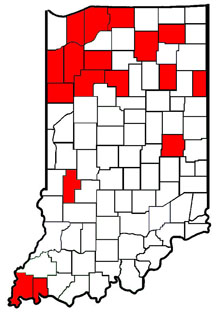Purdue weed scientists offer video to identify Palmer amaranth
July 19, 2013
 |
|
This map of Indiana shows areas, colored in red, where the Palmer amaranth weed has been confirmed. (Purdue Department of Botany and Plant Pathology map) |
WEST LAFAYETTE, Ind. - Two Purdue Extension weed scientists have produced a video to encourage farmers to scout for the fast-spreading Palmer amaranth weed new to Indiana and to help them identify it.
The video (http://extension.entm.purdue.edu/pestcrop/2013/issue16/index.html#identifying) features Bill Johnson and Travis Legleiter in a Cass County, Ind., field that is heavily infested with Palmer amaranth. The two walk producers through identification and show examples of the weed at various growth stages.
Palmer amaranth grows rapidly and seeds quickly, threatening crop yields and bucking many herbicide control methods. It is hard to identify because it closely resembles many other related weeds, commonly referred to as pigweed.
"We encourage growers to view the video in order to distinguish Palmer from other pigweed species, especially common water hemp," Johnson said.
Palmer amaranth is most prevalent in the northern part of Indiana, but has been confirmed in 17 counties statewide: LaPorte, Newton, Jasper, Pulaski, Cass, Benton, Porter, St. Joseph and White in the northwestern part of the state; Adams, Kosciusko, Huntington and Noble in other northern areas; Henry in east-central; Clay in the west; and Posey and Vanderburgh in the extreme southwest.
Both Johnson and Legleiter agree it's one of the biggest weed threats Indiana crop producers have encountered recently.
"This weed is very important and has become somewhat widespread - particularly across the northern one-third of the state," Johnson said. "It presents arguably the most serious weed challenge that we've had in Indiana in quite sometime."
Indiana growers who think they have found Palmer amaranth are encouraged to take multiple in-focus photos of the plant's characteristics - as outlined in the video - and email them along with location information to Johnson (wgj@purdue.edu) or Legleiter (tlegleit@purdue.edu). Submitting that information will help Johnson and Legleiter monitor the weed's presence throughout the state and share that information with other producers.
Palmer amaranth updates are published frequently in Purdue Extension's Pest and Crop Newsletter at http://extension.entm.purdue.edu/pestcrop/index.html
Writer: Jennifer Stewart, 765-494-6682, jsstewar@purdue.edu
Sources: Bill Johnson, 765-494-4656, wgj@purdue.edu
Travis Legleiter, 765-496-2121, tlegleit@purdue.edu
Ag Communications: (765) 494-2722;
Keith Robinson, robins89@purdue.edu
Agriculture News Page

